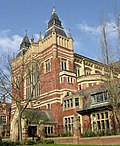
Whittington Hospital is a district general and teaching hospital of UCL Medical School and Middlesex University School of Health and Social Sciences. Located in Upper Holloway, it is managed by Whittington Health NHS Trust, operating as Whittington Health, an integrated care organisation providing hospital and community health services in the north London boroughs of Islington and Haringey. Its Jenner Building, a former smallpox hospital, is a Grade II listed building.

St James's University Hospital is in Leeds, West Yorkshire, England and is popularly known as Jimmy's. It is one of the United Kingdom's most famous hospitals due to its coverage on television. It is managed by the Leeds Teaching Hospitals NHS Trust.

The Countess of Chester Hospital is the main NHS hospital for the English city of Chester and the surrounding area. It currently has 625 beds, general medical departments and a 24-hour accident and emergency unit. It is managed by the Countess of Chester Hospital NHS Foundation Trust, one of the first Foundation Trusts in the UK, formed in 2004. Cardiac rehabilitation services at the hospital are provided by Cheshire and Wirral Partnership NHS Foundation Trust.

Whipps Cross University Hospital is a large university hospital in the locality of Whipps Cross in Leytonstone and is within Epping Forest in the London Borough of Waltham Forest, London, England. It is managed by Barts Health NHS Trust.
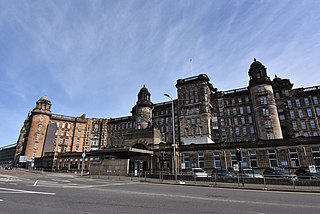
The Glasgow Royal Infirmary (GRI) is a large teaching hospital. With a capacity of around 1,000 beds, the hospital campus covers an area of around 8 hectares, and straddles the Townhead and Dennistoun districts on the north-eastern fringe of the city centre of Glasgow, Scotland. It is managed by NHS Greater Glasgow and Clyde. It was originally opened in 1794, with the present main building dating from 1914.

Southmead Hospital is a large public National Health Service hospital, situated in the area of Southmead, though in Horfield ward, in the northern suburbs of Bristol, England. It is part of the North Bristol NHS Trust. The 800-bed Brunel Building opened in May 2014, to provide services, which transferred from Frenchay Hospital in advance of its closure. The hospital site covers 60 acres (24 ha).

The Bristol Royal Infirmary, also known as the BRI, is a large teaching hospital in the centre of Bristol, England. It has links with the nearby University of Bristol and the Faculty of Health and Social Care at the University of the West of England, also in Bristol.

The Royal Infirmary of Edinburgh (RIE) was established in 1729, and is the oldest voluntary hospital in Scotland. The new buildings of 1879 were claimed to be the largest voluntary hospital in the United Kingdom, and later on, the Empire. The hospital moved to a new 900 bed site in 2003 in Little France. It is the site of clinical medicine teaching as well as a teaching hospital for the University of Edinburgh Medical School. In 1960 the first successful kidney transplant performed in the UK was at this hospital. In 1964 the world's first coronary care unit was established at the hospital. It is the only site for liver, pancreas, and pancreatic islet cell transplantation in Scotland, and one of the country's two sites for kidney transplantation. In 2012, the Emergency Department had 113,000 patient attendances, the highest number in Scotland. It is managed by NHS Lothian.

The Royal Infirmary was a hospital in Upperthorpe, Sheffield, South Yorkshire, England.

Leicester General Hospital (LGH) is a National Health Service hospital located in the suburb of Evington, about three miles east of Leicester City Centre, and is a part of University Hospitals of Leicester NHS Trust. It has approximately 430 beds. The hospital is the largest employer in the area.

The Northern General Hospital is a large teaching hospital and Major Trauma Centre in Sheffield, England. Its departments include Accident and Emergency for adults, with children being treated at the Sheffield Children's Hospital on Western Bank. The hospital is managed by the Sheffield Teaching Hospitals NHS Foundation Trust.
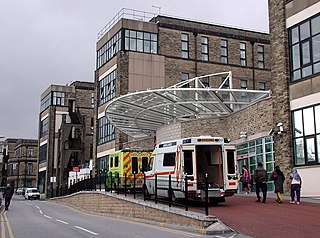
Bradford Royal Infirmary is a large teaching hospital in Bradford, West Yorkshire, England, and is operated by the Bradford Teaching Hospitals NHS Foundation Trust. The infirmary is affiliated with the Leeds School of Medicine.
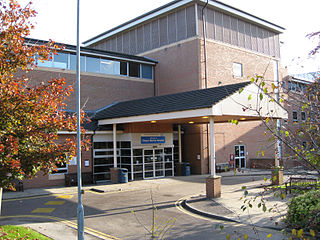
Chapel Allerton Hospital is located in the area of Chapel Allerton, Leeds, West Yorkshire, England and is operated by the Leeds Teaching Hospitals NHS Trust. The main entrance is on Chapeltown Road, with vehicle exits onto Harehills Lane and Newton Road.

Leeds Teaching Hospitals NHS Trust is an NHS hospital trust in Leeds, West Yorkshire, England.
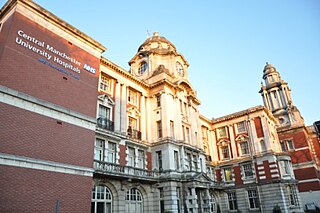
Central Manchester University Hospital NHS Foundation Trust, was a large NHS foundation trust in Manchester, United Kingdom, that was founded in 2009 and merged with University Hospital of South Manchester NHS Foundation Trust in 2017 to form the current Manchester University NHS Foundation Trust.

The Middleton family is an English family that has been related to the British royal family by marriage since the wedding of Catherine Middleton to Prince William in April 2011, when she became the Duchess of Cambridge. The couple have three children: George, Charlotte and Louis. Tracing their origins back to the Tudor era, the Middleton family of Yorkshire of the late 18th century were recorded as owning property of the Rectory Manor of Wakefield with the land passing down to solicitor William Middleton who established the family law firm in Leeds which spanned five generations. Some members of the firm inherited woollen mills after the First World War. By the turn of the 20th century, the Middleton family had married into the British nobility and, by the 1920s, the family were playing host to the British royal family.
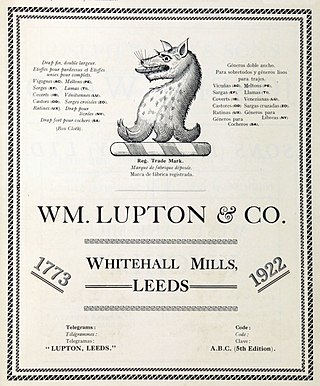
The Lupton family in Yorkshire achieved prominence in ecclesiastical and academic circles in England in the Tudor era through the fame of Roger Lupton, provost of Eton College and chaplain to Henry VII and Henry VIII. By the Georgian era, the family was established as merchants and ministers in Leeds. Described in the city's archives as "landed gentry, a political and business dynasty", they had become successful woollen cloth merchants and manufacturers who flourished during the Industrial Revolution and traded throughout northern Europe, the Americas and Australia.

Frances Elizabeth Lupton was an Englishwoman of the Victorian era who worked to open up educational opportunities for women. She married into the politically active Lupton family of Leeds, where she co-founded Leeds Girls' High School in 1876 and was the Leeds representative of the North of England Council for Promoting the Higher Education of Women.

Roundhay Hall is a Grade II listed building in Leeds, West Yorkshire, England. Built in the 19th century as a residence for William Smith, the building is now a hospital. The hall is in the Neo-classical style and is a design of Yorkshire architect Samuel Sharp.
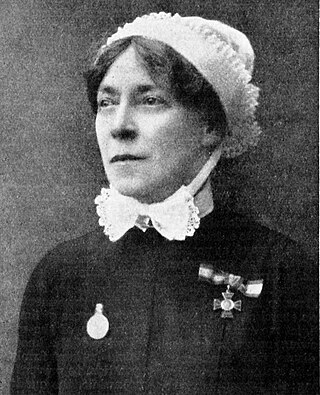
Euphemia Steele Innes RRC DN was a Scottish nurse who served for 21 years as matron at Leeds General Infirmary in Leeds, West Riding of Yorkshire, England. She was decorated with the Royal Red Cross 1st class in 1916 for services with the Territorial Force Nursing Service in the First World War.







































